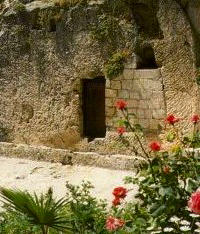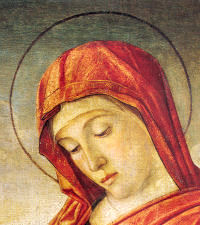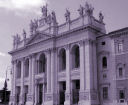1. Now upon the first day of the week, very early in the morning, they came to the sepulcher, bringing the spices which they had prepared, and certain others with them.
2. And they found the stone rolled away from the sepulcher.
3. And they entered in, and found not the body of the Lord Jesus.
4. And it came to pass, as they were much perplexed thereabout, behold, two men stood by them in shining garments:
5. And as they were afraid, and bowed down their faces to the earth, they said to them, Why seek you the living among the dead?
6. He is not here, but is risen: remember how he spoke to you when he was yet in Galilee,
7. Saying, The Son of man must be delivered into the hands of sinful men, and be crucified, and the third day rise again.
8. And they remembered his words,
9. And returned from the se sepulcher, and told all these things to the eleven, and to all the rest.
10. It was Mary Magdalene, and Joanna; and Mary the mother of James, and other women that were with them, which told these things to the apostles.
11. And their words seemed to them as idle tales, and they believed them not.
12. Then arose Peter, and ran to the sepulcher; and stooping down, he beheld the linen clothes laid by themselves, and departed, wondering in himself at that which was come to pass.
BEDE; Devout women not only on the day of preparation, but also when the sabbath was passed, that is, at sun-set, as soon as the liberty of working returned, bought spices that they might come and anoint the body of Jesus, as Mark testifies. Still as long as night time restrained them, they came not to the sepulcher. And therefore it is said, On the first day of the week, very early in the morning, &c. One of the Sabbath, or the first of the Sabbath, is the first day from the Sabbath; which Christians are wont to call "the Lord s day", because of our Lord's resurrection. But by the women coming to the sepulcher very early in the morning, is manifested their great zeal and fervent love of seeking and finding the Lord.
AMBROSE; Now this place has caused great perplexity to many, because while St. Luke says, Very early in the morning, Matthew says that it was in the evening of the sabbath that the women came to the sepulcher. But you may suppose that the Evangelists spoke of different occasions, so as to understand both different parties of women, and different appearances. Because however it was written, that in the evening of the sabbath, as it began to dawn towards the first day of the week, our Lord rose, we must so take it, as that neither on the morning of the Lord's day, which is the first after the sabbath, nor on the sabbath, the resurrection should be thought to have taken place. For how are the three days fulfilled; Not then as the day grew towards evening, but in the evening of the night He rose. Lastly, in the Greek it is "late;" but late signifies both the hour at the end of the day, and the slowness of any thing; as we say, "I have been lately told." Late then is also the dead of the night. And thus also the women had the opportunity of coming to the sepulcher when the guards were asleep. And that you may know it was in the night time, some of the women are ignorant of it. They know who watch night and day, they know not who have gone back. According to John, one Mary Magdalene knows not, for the same person could not first know and then afterwards be ignorant. Therefore if there are several Marys, perhaps also there are several Mary Magdalenes, since the former is the name of a person, the second is derived from a place.
AUG. Or Matthew by the first part of the night, which is the evening, wished to represent the night itself, at the end of which night they came to the sepulcher, and for this reason, because they had been now preparing since the evening, and it was lawful to bring spices because the sabbath was over.
EUSEB. The Instrument of the Word lay dead, but a great stone enclosed the sepulcher, as if death had led Him captive. But three days had not yet elapsed, when life again puts itself forth after a sufficient proof of death, as it follows, And they found the stone rolled away.
THEOPHYL. An angel had rolled it away, as Matthew declares.
CHRYS. But the stone was rolled away after the resurrection, on account of the women, that they might believe that the Lord had risen again, seeing indeed the grave without the body. Hence it follows, And they entered in, and found not the body of the Lord Jesus
CYRIL; When then they found not the body of Christ which was risen, they were distracted by various thoughts, and for their love of Christ and the tender care they had shown Him, were thought worthy of the vision of angels. For it follows, And it came to pass as they were much perplexed thereabout, behold, two men stood by them in shining garments.
EUSEB. The messengers of the health-bearing resurrection and their shining garments stand for tokens of pleasantness and rejoicing. For Moses preparing plagues against the Egyptians, perceived an angel in the flame of fire. But not such were those who appeared to the women at the sepulcher, but calm and joyful as became them to be seen in the kingdom and joy of the Lord. And as at the Passion the sun was darkened, holding forth signs of sorrow and woe to the crucifiers of our Lord, so the angels, heralds of life and resurrection, marked by their white garments the character of the health-bearing feast day.
AMBROSE; But how is it that Mark has mentioned one young man sitting in white garments, and Matthew one, but John and Luke relate that there were seen two angels sitting in white garments.
AUG. We may understand that one Angel was seen by the women, as both Mark and Matthew say, so as supposing them to have entered into the sepulcher, that is, into a certain space which was fenced off by a kind of wall in front of the stone sepulcher; and that there they saw an Angel sitting on the right hand, which Mark says, but that afterwards when they looked into the place where our Lord was lying, they saw within two other Angels standing, (as Luke says,) who spoke to encourage their minds, and build up their faith. Hence it follows, And as they were afraid,.
BEDE; The holy women, when the Angels stood beside them, are reported not to have fallen to the ground, but to have bowed their faces to the earth; nor do we read that any of the saints, at the time of our Lord's resurrection, worshipped with prostration to the ground either our Lord Himself, or the Angels who appeared to them. Hence has arisen the ecclesiastical custom, either in memory of our Lord's resurrection, or in the hope of our own, of praying on every Lord's day, and through the whole season of Pentecost, not with bended knees, but with our faces bowed to the earth. But not in the sepulcher, which is the place of the dead, was He to be sought, who rose from the dead to life. And therefore it is added, They said to them, that is, the Angels to the women, Why seek you the living among the dead? He is not here, but is risen. On the third day then, as He Himself foretold to the women, together with the rest of His disciples, He celebrated the triumph of His resurrection.
Hence it follows, Remember how he spoke to you when he was yet in Galilee, saying, The Son of man must be delivered into the hands of sinful men, and be crucified, and on the third day rise again, &c. For on the day of the preparation at the ninth hour giving up the ghost, buried in the evening, early on the morning of the first day of the week He rose again.
ATHAN. He might indeed at once have raised His body from the dead. But some one would have said that He was never dead, or that death plainly had never existed in Him. And perhaps if the resurrection of our Lord had been delayed beyond the third day, the glory of incorruption had been concealed. In order therefore to show His body to be dead, He suffered the interval of one day, and on the third day manifested His body to be without corruption.
BEDE; One day and two nights also He lay in the sepulcher, because He joined the light of His single death to the darkness of our double death.
CYRIL; Now the women, when they had received the sayings of the Angels, hastened to tell them to the disciples; as it follows,
And they remembered his words, and returned from the sepulcher, and told all these things to the eleven, and to all the rest. For woman who was once the minister of death, is now the first to receive and tell the awful mystery of the resurrection. The female race has obtained therefore both deliverance from reproach, and the withdrawal of the curse.
AMBROSE; It is not allowed to women to teach in the church, but they shall ask their husbands at home. To those then who are at home is the woman sent. But who these women were he explains, adding, It was Mary Magdalene,
BEDE; (who was also the sister of Lazarus,) and Joanna, (the wife of Chuza, Herod's steward,) and Mary the mother of James, (that is, the mother of James the less, and Joseph.) And it is added generally of the others, and other women that were with them, which told these things to the Apostles.
BEDE; For that the woman might not endure the everlasting reproach of guilt from men, she who had transfused sin into the man, now also transfuses grace.
THEOPHYL. Now the miracle of the resurrection is naturally incredible to mankind. Hence it follows, And their words seemed to them as idle tales.
BEDE; Which was not so much their weakness, as so to speak our strength. For the resurrection itself was demonstrated to those who doubted by many proofs, which while we read and acknowledge we are through their doubts confirmed in the truth.
THEOPHYL. Peter, as soon as he heard this, delays not, but runs to the sepulcher; for fire when applied to matter knows no delay; as it follows, Then arose Peter, and ran to the sepulcher.
EUSEB. For he alone believed the women saying that they had seen Angels; and as he was of more ardent feelings than the rest, he anxiously put himself foremost, looking every where for the Lord; as it follows, And stooping down, he beheld the linen clothes laid by themselves.
THEOPHYL. But now when he was at the tomb, he first of all obtained that he should marvel at those things which had before been derided by himself or the others; as it is said, And departed, wondering in himself at that which was come to pass; that is, wondering in himself at the way in which it had happened, how the linen clothes had been left behind, since the body was anointed with myrrh; or what opportunity the thief had obtained, that putting away the clothes wrapped up by themselves, he should take away the body with the soldiers standing round.
AUG. Luke is supposed to have mentioned this concerning Peter, recapitulating. For Peter ran to the sepulcher at the same time that John also went, as soon as it had been told to them alone by the women, (especially Mary Magdalene,) that the body was taken away. But the vision of Angels took place afterwards. Luke therefore mentioned Peter only, because to him Mary first told it. It may also strike one, that Luke says that Peter, not entering but stooping down, saw the linen clothes by themselves, and departed wondering, whereas John says, that he himself saw the linen clothes in the same position, and that he entered after Peter. We must understand then that Peter first saw them stooping down, which Luke mentions, John omits, but that he afterwards entered before John came in.
BEDE; According to the mystical meaning, by the women coming early in the morning to the sepulcher, we have an example given us, that having cast away the darkness of our vices, we should come to the Body of the Lord. For that sepulcher also bore the figure of the Altar of the Lord, wherein herein the mysteries of Christ's Body, not in silk or purple cloth, but in pure white linen, like that in which Joseph wrapped it, ought to be consecrated, that as He offered up to death for us the true substance of His earthly nature, so we also in commemoration of Him should place on the Altar the flax, pure from the plant of the earth, and white, and in many ways refined by a kind of crushing to death. But the spices which the women bring, signify the odor of virtue, and the sweetness of prayers by which we ought to approach the Altar. The rolling back of the stone alludes to the unclosing of the Sacraments which were concealed by the veil of the letter of the law which was written on stone, the covering of which being taken away, the dead body of the Lord is not found, but the living body is preached; for although we have known Christ according to the flesh, yet now henceforth know we Him no more. But as when the Body of our Lord lay in the sepulcher, Angels are said to have stood by, so also at the time of consecration are they to be believed to stand by the mysteries of Christ. Let us then after the example of the devout women, whenever we approach the heavenly mysteries because of the presence of the Angels, or from reverence to the Sacred Offering, with all humility, bow our faces to the earth, recollecting that we are but dust and ashes.
Catena Aurea Luke 24








 Holy Saturday (from Sabbatum Sanctum, its official liturgical name) is sacred as the day of the Lord's rest; it has been called the "Second Sabbath" after creation. The day is and should be the most calm and quiet day of the entire Church year, a day broken by no liturgical function. Christ lies in the grave, the Church sits near and mourns. After the great battle He is resting in peace, but upon Him we see the scars of intense suffering...The mortal wounds on His Body remain visible....Jesus' enemies are still furious, attempting to obliterate the very memory of the Lord by lies and slander.
Holy Saturday (from Sabbatum Sanctum, its official liturgical name) is sacred as the day of the Lord's rest; it has been called the "Second Sabbath" after creation. The day is and should be the most calm and quiet day of the entire Church year, a day broken by no liturgical function. Christ lies in the grave, the Church sits near and mourns. After the great battle He is resting in peace, but upon Him we see the scars of intense suffering...The mortal wounds on His Body remain visible....Jesus' enemies are still furious, attempting to obliterate the very memory of the Lord by lies and slander. 



